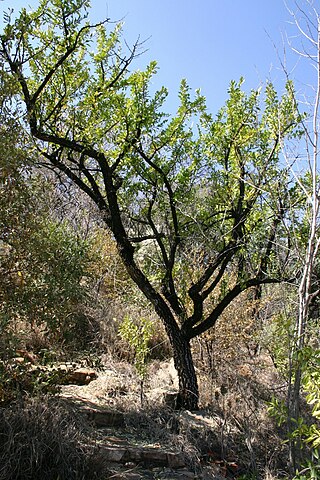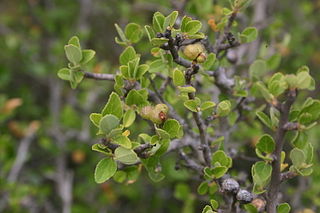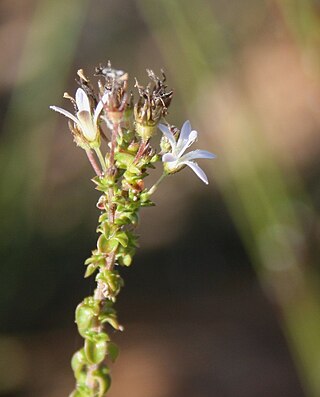
Carpinus caroliniana, the American hornbeam, is a small hardwood tree in the genus Carpinus. American hornbeam is also known as blue-beech, ironwood, musclewood and muscle beech. It is native to eastern North America, from Minnesota and southern Ontario east to Maine, and south to eastern Texas and northern Florida. It also grows in Canada. It occurs naturally in shaded areas with moist soil, particularly near the banks of streams or rivers, and is often a natural constituent understory species of the riverine and maritime forests of eastern temperate North America.

Raphanus raphanistrum, also known as wild radish, white charlock or jointed charlock, is a flowering plant in the family Brassicaceae. One of its subspecies, Raphanus raphanistrum subsp. sativus, includes a diverse variety of cultivated radishes. The species is native to western Asia, Europe and parts of Northern Africa. It has been introduced into most parts of the world and is regarded as a habitat threatening invasive species in many areas, for example, Australia. It spreads rapidly and is often found growing on roadsides or in other places where the ground has been disturbed.

Lamium amplexicaule, commonly known as common henbit, or greater henbit, is a species of Lamium native to Europe, Asia and northern Africa.

Quercus imbricaria, the shingle oak, is a deciduous tree in the red oak group of oaks. It is native primarily to the Midwestern and Upper South regions of North America.

Momordica balsamina is a tendril-bearing annual vine native to the tropical regions of Africa, introduced and invasive in Asia, Australia, Central America, and North America, where they have been found in some parts of Florida. In 1810, Thomas Jefferson planted this vine in his flower borders at Monticello along with larkspur, poppies, and nutmeg.

Ipomoea indica is a species of flowering plant in the family Convolvulaceae, known by several common names, including blue morning glory, oceanblue morning glory, koali awa, and blue dawn flower. It bears heart-shaped or 3-lobed leaves and purple or blue funnel-shaped flowers 6–8 cm (2–3 in) in diameter, from spring to autumn. The flowers produced by the plant are hermaphroditic. This plant has gained the Royal Horticultural Society's Award of Garden Merit.

Salvia fruticosa, or Greek sage, is a perennial herb or sub-shrub native to the eastern Mediterranean, including Southern Italy, the Canary Islands and North Africa. It is especially abundant in Palestine, Israel and Lebanon.

Gymnosporia is an Old World genus of plants, that comprise suffrutices, shrubs and trees. It was formerly considered congeneric with Maytenus, but more recent investigations separated it based on the presence of achyblasts and spines, alternate leaves or fascicles of leaves, an inflorescence that forms a dichasium, mostly unisexual flowers, and fruit forming a dehiscent capsule, with an aril on the seed. It is dioecious, with male and female flowers on separate plants.
Pittosporum virgatum is a species of plant in the Pittosporaceae family. It is endemic to New Zealand.

Lepidium densiflorum is a species of flowering plant in the mustard family known by the common names common pepperweed and prairie peppergrass.

Fumaria muralis, known as common ramping-fumitory or wall fumitory, is a flowering herbaceous plant in the poppy family (Papaveraceae) native to western Europe and northwestern Africa.

Gymnosporia heterophylla, the common spike-thorn, is a small, hardy, deciduous African tree up to 5m tall, occurring in rocky places with a wide distribution from Ethiopia, the Sudan and the Congo, south to the Cape Province and west to Angola and Namibia, as well as the neighbouring islands of Madagascar and Saint Helena, with a closely related species from Mauritius.

Euclea crispa, commonly known as the blue guarri, is an Afrotropical plant species of the family Ebenaceae. The hardy and evergreen plants may form a dense stand of shrubs, or grow to tree size. It is widespread and common in the interior regions of southern Africa, and occurs northward to the tropics. Though some are present near the South African south and east coasts, they generally occur at middle to high altitudes. It is readily recognizable from its much-branched structure and dull bluish foliage colour. Those bearing lanceolate leaves may however resemble the Wild olive, another common species of the interior plateaus.

Grewia robusta is a multi-stemmed shrub or small tree, up to 3 m high, endemic to the semi-desert Karoo of South Africa, and very similar to Grewia occidentalis. It is one of some 325 species of Grewia in the family Malvaceae, and having a tropical African, Asian and Australian distribution. It is found in the arid regions of the Karoo and Eastern Cape, and generally prefers growing among dry scrub on rocky hillsides.

Guthriea capensis is an acaulescent perennial herb endemic to South Africa and occurring in cool and damp sites facing south or east in the mountains of the Cape Province, Lesotho and KwaZulu-Natal. Guthriea is monotypic and was named after the botanist and mathematician Francis Guthrie by his friend the botanist Harry Bolus.

Gymnosporia buxifolia is a species of plant in the bittersweet family (Celastraceae) native to southern Africa. It is commonly known as the pioneer spike-thorn or common spike-thorn. It ranges from Angola and Mozambique to South Africa.

Wahlenbergia tenella is a herbaceous plant in the family Campanulaceae native to the southern Cape regions of South Africa.

Babiana scabrifolia is a perennial plant of 5–15 cm (2.0–5.9 in) high that annually forms leaves and flowers from an underground corm and is assigned to the Iris family. It produces relatively large, pale lilac or blue flowers slightly above the soil, and soft, lightly pleated leaves that reach beyond the flowers. These leaves are lance-shaped to oblong in adults, but line-shaped and twisted in non-flowering specimens. Flowering occurs from June to August. The species can be found in the Western Cape province of South Africa.

Myriopteris rawsonii, formerly known as Cheilanthes rawsonii, is a perennial fern native to Namaqualand in Southern Africa. Like many other cheilanthoid ferns, it is adapted to dry conditions, bearing a thick layer of pale hairs on the underside of its pinnate-pinnatifid leaves. It is the only African representative of its clade of cheilanthoids, the otherwise American genus Myriopteris. It spends much of the year in a dried-out, dormant state, rehydrating and putting out new growth during winter rains. Its name honors the botanist and civil servant Sir Rawson W. Rawson.




















